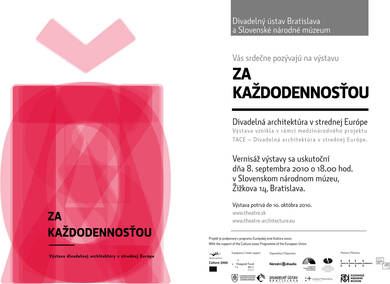BEYOND EVERYDAYNESS
9. September – 10. October, Bratislava (Slovakia)
The place of the exhibition: Slovak National Museum (Slovenské národné múzeum Výstavný pavilón Podhradie, Žižkova 14) in Bratislava, Slovakia it was organised by the Theatre Institute, Bratislava. .
A festive opening speech was made by Ms.Vladislava Fekete, director of the Theatre Institute, Bratislava and Ms. Viera Dlháňová, Academy of Science Slovakia – department of architecture. The speaker from Prague was Jan Rolnik, one of the TACE project leaders. Exhibition “Beyond Everydayness” was organized in the partnership with the Slovak National Museum, and it was presented in very nice exhibition space in Bratislava. More than 1000 visitors for one month came to visit the exhibition.
For exhibition, it was printed following materials:
Invitation. Catalogue, billboard, posters (100 posters were promoting the exhibition around city of Bratislava)
Guided tours of exhibition were organised on Saturdays:
September 25 – Viera Dlhaňová, expert on theatre architecture, Slovak Academy of Science
October 5 - Viera Dlhaňová, expert on theatre architecture, Slovak Academy of Science
Accompanying programme:
ARCHITECTURE WORKSHOP - Theatre as Urban Study – I.
Lectors: Espen Rahlff a Ingvild Bennet, Norway
16 December – 17 December 2010
City Library Bratislava
Theatre workshop was last for two days 16th – 17th of December in the premises of city library Bratislava and it was organized by Theatre Institute from Bratislava.
10 students from 2 architecture schools participated at the workshop. Topics of the workshop were: Variety / diversity of theatre construction Multi-functional theatre construction Theatre as an urban study Implementation of the ideological construction of the theatre vs. Practical design. The main goal of the workshop was to discuss interdisciplinary aspects of a theatre building, its current status with respect to the original architectural design in the European context. Thanks to what we see each other? And thus we see? It is the scene and its locations are important. Students were asked to look "scene", but not in theatre but in the city. This gave rise to several live events in the city center, the performance scene in the streets, a space for interaction and play. Results were presented in the Gallery on Friday 17th Artotheque 12. 2010 at 17.00.




 1
1 1
1 1
1 1
1 1
1